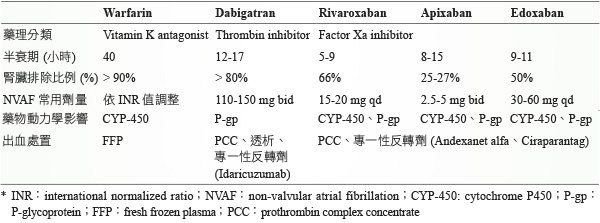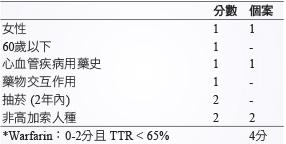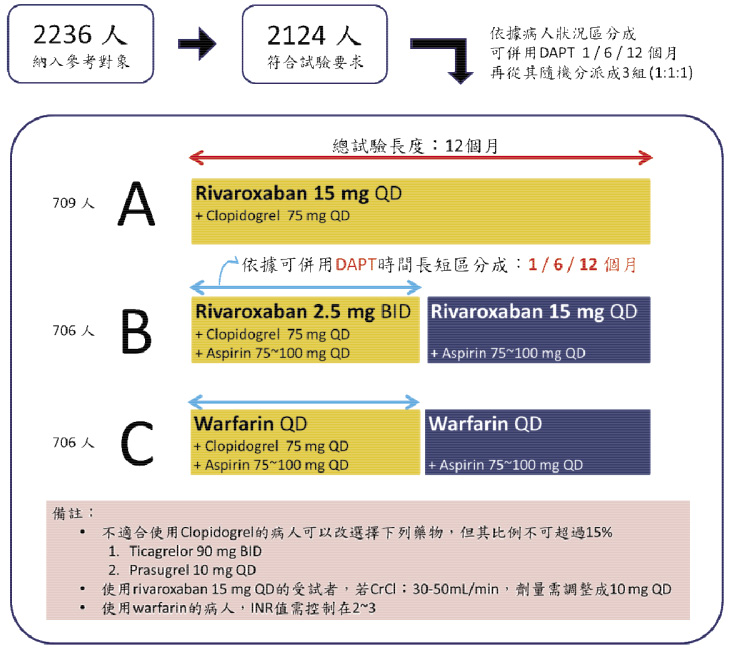摘要
心房纖維顫動可能會增加病人發生心臟衰竭或中風的風險,如同時罹患冠狀動脈心臟病,其中風的風險盛行率會隨個案年齡而逐漸增加;依常見臨床指引建議,針對心房纖維顫動併有冠狀動脈心臟病的病人需同時使用抗凝血劑與抗血小板藥品,但兩類藥品併用可能會增加出血的風險。本案例是一位61歲診斷有心房纖維顫動及冠心症的女性,經醫療團隊評估其中風風險 CHA2DS2-VASc 為5分 (屬高中風風險)、出血風險 HAS-BLED 為2分 (屬低出血風險)、藥物評估 SAM-TTR2R2為4分 (適合非 vitamin K 拮抗作用口服抗凝血劑),透過臨床實證查證及團隊討論,共識針對合併有心房纖維顫動與冠狀動脈心臟病病人之合宜口服抗凝血劑與抗血小板藥品,希冀能獲得最佳的治療效益,並降低出血副作用的風險。
關鍵字: 心房纖維顫動、冠心症、抗凝血藥物、atrial fibrillation、coronary heart disease、anticoagulant agents
壹、前言
依據近幾年的國人十大死因調查結果,心血管疾病及腦血管疾病持續高居前幾名次,而心房纖維顫動 (atrial fibrillation;AF) 病人常同時罹患冠狀動脈心臟病 (coronary artery disease; CAD)1,部分急性冠心症 (acute coronary syndrome; ACS) 病人需接受支架的介入性治療,依據臨床治療指引建議,介入治療後需要併用抗凝血劑與抗血小板藥物來預防中風或栓塞事件,但兩類藥品併用可能會增加出血的風險2;此類病人傳統上會選擇處方 warfarin 藥物,依非瓣膜性心房纖維顫動病人使用非 vitamin K 拮抗作用口服抗凝血劑 (non–vitamin K antagonist oral anticoagulants, NOACs) 的臨床試驗結果,NOACs 的出血風險可能較 warfarin 低。針對併有心房纖維顫動與冠狀動脈心臟病病人使用 NOACs 的療效與安全性,另與傳統 warfarin 藥物的臨床差異,仍需更多的臨床試驗及使用經驗來進一步證實。
貳、病例
個案為61歲女性,曾有高血壓、心臟衰竭及腦中風的病史,於2016年6月6日凌晨因胸痛入院,經急診診斷為急性冠心症,心電圖顯示為心房纖維顫動,胸部X光顯示有心室肥大、雙側肺部積水的情形,次日心電圖檢查發現 ST 波段 V1-V3上升,醫生診斷為 ST 段上升型心肌梗塞 (ST segment elevation myocardial infarction;STEMI),同時發現左右側冠狀動脈皆有50%以上的阻塞,初步懷疑與遠端冠狀動脈血栓與心房纖維顫動相關,醫療團隊以經皮冠狀動脈介入性導管 (percutaneous coronary intervention;PCI) 方式執行氣球擴張術並移除血栓,延續處方 aspirin 與 clopidogrel 抗血小板藥物,經團隊討論後,其中風的風險 CHA2DS2-VASc3為5分 (屬高中風風險)、出血風險 HAS-BLED4為2分 (屬低出血風險)、藥物評估 SAM-TTR2R25為4分,決定新增處方 rivaroxaban 抗凝血劑,並轉至心臟血管加護病房作後續治療與評估,病人於加護病房時未再抱怨胸痛且血液動力學等生命跡象穩定;3日後 (6月9日) 因胸痛使用 nitroglycerin (NTG) 舌下錠,因 Troponin-T 上升 (1,400-2,000 ng/mL) 而再次接受心導管治療;14日因病情穩定出院,出院帶藥處方使用 rivaroxaban、ticagrelor 與 aspirin (表一)。
表一 用藥紀錄

參、討論
心房纖維顫動病人發生中風的風險是其他族群的5倍,中風後的致死率高6,因此積極使用抗擬血劑來預防中風是非常重要的議題,臨床上可處方使用 warfarin (vitamin K antagonist;VKA) 或非 vitamin K 拮抗作用口服抗凝血劑 (表二)7。NOACs 常使用於非瓣膜性心房纖維顫動 (non-valvular atrial fibrillation;NVAF) 的病人來預防中風,NOACs 具有選擇性抑制特定凝血因子的特色,相較於傳統 warfarin 藥物,其半衰期較短、藥物交互作用較少,但需依照腎臟功能狀況調整藥物使用劑量。
表二 Vitamin K Antagonist 與 Non–Vitamin K Antagonist Oral Anticoagulants 臨床比較4

臨床上,針對非瓣膜性心房纖維顫動病人可先依據 CHA2DS2-VASc (表三) 評估其中風風險,並依評估的風險等級決定是否需要給予抗凝血藥物治療;醫療團隊可以利用 HAS-BLED (表四) 評估病人使用抗凝血藥物的潛在出血風險,如屬於出血高風險族群,需要特別謹慎以避免重大出血事件。另外,可藉由 SAM-TTR2R2 (表五) 評估結果來決定處方使用 warfarin 或 NOACs 藥物8,9。經評估,個案為中風高危險群 (CHA2DS2-VASc:5分)、低出血風險 (HAS-BLED:2分)、適合使用 NOACs (SAM-TTR2R2:4分)。經文獻查詢,ATLAS ACS 2-TIMI 51試驗針對近期曾發生急性冠心症且已使用標準抗血小板藥物治療的病人,比較 rivaroxaban (2.5-5 mg bid) 與安慰劑的差異,結果發現 rivaroxaban 能顯著減少因心血管相關致死率 (8.9% vs 10.7%; HR, 0.84; 95% CI, 0.74-0.96; p = 0.008),雖未顯著增加致死性出血的風險,但增加主要出血事件及顱內出血事件的機率10。
表三 CHA2DS2-VASc 評分表3

表四 HAS-BLED 評分表4

表五 SAM-TTR2R2 評分表5

根據 PIONEER AF-PCI 試驗針對非瓣膜性心房纖維顫動且接受經皮冠狀動脈介入性導管施作血管內支架後,比較不同劑量 rivaroxaban (15 mg qd 與2.5 mg bid) 或 warfarin 的臨床差異,共收入2,124位病人,CHA2DS2-VASc 分數多為3-5分;病人隨機分配成3組,A組使用 rivaroxaban 15 mg qd 併用 clopidogrel,B組為 rivaroxaban 2.5 mg bid 併用 aspirin 與 clopidogrel,C組為 warfarin 併用 aspirin 與 clopidogrel (圖一)。試驗結果顯示 rivaroxaban 兩組比 warfarin 組有較低的臨床出血風險 (A:B:C=16.8%:18.0%:26.7%; HR for A to C, 0.59; 95% CI, 0.47-0.76; p < 0.001; HR for B to C, 0.63; 95% CI, 0.50-0.80; p < 0.001);三組在心血管事件 (心血管相關死亡、心肌梗塞、中風) 發生率無顯著差異。此試驗的研究限制包含試驗規模不大,可能無法準確指出是否優於傳統的藥物治療,另外,病人併用兩種抗血小板藥物的時間長短 (1、6、12個月) 是依據研究人員判斷,非隨機分配,且未將支架栓塞情形納入評量項目11。現階段 rivaroxaban 使用於心房纖維顫動合併冠狀動脈疾病的病人,其臨床療效與安全性仍需更多的研究來證實。

* DAPT: dual antiplatelet therapy
圖一 PIONEER AF-PCI 試驗簡易流程圖8
根據歐洲心臟醫學會 (European Society of Cardiology;ESC) 於2016年的臨床診療準則12-15,針對非瓣膜性心房纖維顫動合併急性冠心症的病人,如 CHA2DS2-VASc 評分為2分以上且 HAS-BLED 介於0-2分,建議口服使用1種抗凝血劑合併雙重抗血小板藥物至少6個月,如 HAS-BLED 評分為3分以上的高出血風險病人,則建議三種藥物至少使用4周,之後再依風險適度調整為1種抗凝血劑合併1種抗血小板藥物,1年後可考慮單獨使用1種口服抗凝血劑 (表六)。
表六 ESC 針對 NVAF+ACS 臨床診療準則9

肆、結論
非瓣膜性心房纖維顫動併有冠心症的病人,依建議須接受抗凝血劑合併抗血小板藥物,醫療團隊可先依 CHA2DS2-VASc 評估其中風風險並決定是否需處方使用口服抗凝血劑,利用 HAS-BLED 評估出血風險,針對出血風險程度調整處方及衛教指導,如有需求可依照 SAMe-TT2R2 評估使用 warfarin 或是 NOACs,另有部分臨床研究結果建議可考慮使用低劑量 rivaroxaban。本個案經評估後處方使用 rivaroxaban 與雙重抗血小板藥物。未來仍需更多的臨床證據來評估此類病人的藥物療效與安全性,以守護病人的用藥安全。
伍、致謝
感謝亞東紀念醫院藥學部於實習期間的協助,透過每位學長姐的細心教學,讓實習更加豐富且受益良多,謝謝王明賢藥師針對臨床個案報告的指導,並共同完成期刊投稿;聲明亞東紀念醫院王明賢藥師為此篇文章的相同貢獻第一作者。
A Case Report with Atrial Fibrillation and Coronary Heart Disease Taking the Anticoagulant Agent
Kai-Yueh, Chang1, Ming-Shyan Wang2
Pharmacy Student, Chia Nan University of Pharmacy and Science1
Department of Pharmacy, Far Eastern Memorial Hospital2
Abstract
Patients with atrial fibrillation may have a higher risk of stroke or heart failure. The prevalence of atrial fibrillation in patients with coronary artery disease is increased with age. According to major guidelines, such patients should take oral anticoagulants in combination with anti-platelet agents for the reduction of the risk of thrombosis and stroke, but also be monitored for potential bleeding risk. This is a case of a 61 years old woman who was diagnosed coronary heart disease and atrial fibrillation. Her CHA2DS2-VASc Score is 5 points, HAS-BLED Score is 2 points and SAM-TTR2R2 Score is 4 points. Based on these risk factors, we will discuss about the pharmacotherapeutic treatment of atrial fibrillation in patients with coronary artery disease.
參考資料:
1.Lokshyn S, Mewis C, Kuhlkamp V: Atrial fibrillation in coronary artery disease. Int J Cardiol 2000; 72: 133-6.
2. Friberg L, Rosenqvist M, Lip GY: Evaluation of risk stratification schemes for ischaemic stroke and bleeding in 182,678 patients with atrial fibrillation: the Swedish Atrial Fibrillation cohort study. Eur Heart J 2012; 33: 1500-10.
3. January CT, Wann LS, Alpert JS, et al: 2014 AHA/ACC/HRS guideline for the management of patients with atrial fibrillation: a report of the American College of Cardiology/American Heart Association Task Force on Practice Guidelines and the Heart Rhythm Society. J Am Coll Cardiol 2014; 64(21): 2305-7.
4. Pisters R, Lane DA, Nieuwlaat R, et al: A novel user-friendly score (HAS-BLED) to assess 1-year risk of major bleeding in patients with atrial fibrillation: the Euro Heart Survey. Chest 2010; 138(5): 1093-100.
5. Apostolakis S, Sullivan RM, Olshansky B, et al: Factors affecting quality of anticoagulation control among patients with atrial fibrillation on warfarin: the SAMe-TT2R2 score. Chest 2013; 144(5): 1555-63.
6. Staffan Björck, Bo Palaszewski, Leif Friberg , et al: Atrial fibrillation, stroke risk, and warfarin therapy revisited: a population-based study. Stroke 2013; 44(11): 3103-8.
7. Abdulla Shehab, Asim Ahmed Elnour, Akshaya Srikanth Bhagavathula, et al: Novel oral anticoagulants and the 73rd anniversary of historical warfarin. J Saudi Heart Assoc 2016; 28: 31-45.
8. Lip GY, Nieuwlaat R, Pisters R , et al: Refining clinical risk stratification for predicting stroke and thromboembolism in atrial fibrillation using a novel risk factor-based approach: the Euro Heart Survey on Atrial Fibrillation. Chest 2010; 137(2): 263-72.
9. Gregory Y. H. Lip, Deirdre A. Lane: Stroke prevention in atrial fibrillation: a system review. JAMA 2015; 313(19): 1950-62.
10. Jessica L. Mega, Eugene Braunwald, Stephen D. Wiviott, et al: Rivaroxaban in Patients with a Recent Acute Coronary Syndrome. N Engl J Med 2012;366:9-19.
11. C. Michael Gibson, Roxana Mehran, Christoph Bode, et al: Prevention of bleeding in patients with atrial fibrillation undergoing PCI. N Engl J Med 2016; 375(25): 2423-34.
12. Lip GY, Windecker S, Huber K , et al: Management of antithrombotic therapy in atrial fibrillation patients presenting with acute coronary syndrome and/or undergoing percutaneous coronary or valve interventions: a joint consensus document of the European Society of Cardiology Working Group on Thrombosis, European Heart Rhythm Association (EHRA), European Association of Percutaneous Cardiovascular Interventions (EAPCI) and European Association of Acute Cardiac Care (ACCA) endorsed by the Heart Rhythm Society (HRS) and Asia-Pacific Heart Rhythm Society (APHRS). Eur Heart J 2014; 35: 3155-79.
13. Braun OÖ, Bico B, Chaudhry U, et al: Concomitant use of warfarin and ticagrel or as an alternative to triple antithrombotic therapy after an acute coronary syndrome. Thromb Res 2015;135: 26-30.
14. Sarafoff N, Martischnig A, Wealer J, et al: Triple therapy with aspirin, prasugrel, and vitamin K antagonists in patients with drug-eluting stent implantation and an indication for oral anticoagulation. J Am Coll Cardiol 2013;61: 2060-6.
15. Paulus Kirchhof: 2016 ESC Guidelines for the management of atrial fibrillation developed in collaboration with EACTS. European Heart Journal 2016; 37: 2893-962.
通訊作者:王明賢/通訊地址:新北市板橋區南雅南路二段21號
服務單位:亞東紀念醫院藥學部藥師/聯絡電話:(O) 02-89667000

